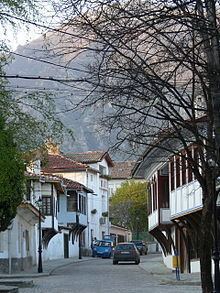Time zone EET (UTC+2) Website Official website Population 30,340 (2012) Local time Friday 5:42 PM | Postal Code 4300 Elevation 452 m Area code 0335 | |
 | ||
Weather 4°C, Wind NW at 13 km/h, 91% Humidity | ||
Bulgaria karlovo
Kàrlovo (Bulgarian: Карлово) is a picturesque and a historically important town in central Bulgaria located in a fertile valley along the river Stryama at the southern foot of the Balkan Mountains. It is administratively part of Plovdiv Province and has a population of about 30,340 (as of 2011), the mayor being D-r Emil Kabaivanov.
Contents
- Bulgaria karlovo
- Map of Karlovo Bulgaria
- History
- Geography
- Climate
- Infrastructure and transport
- Municipality
- Notable natives
- Notable events
- Landmarks
- Museums
- Other
- Honour
- Town twinning
- References
Map of Karlovo, Bulgaria
Karlovo is famous for the worldwide-known rose oil, which is grown there and used in producing perfume. In addition to this, Karlovo is the birthplace of Vasil Levski, the most distinguished Bulgarian to start preparing the national liberation from the Ottoman rule in the late 19th century. There is a museum and large monument dedicated to him. Karlovo is also a popular location for tourism in the region.
During the 2000s, Bulgarian archaeologists made discoveries in Central Bulgaria which were summarized as "The Valley of the Thracian Kings". On 19 August 2005, some archaeologists announced they had found the first Thracian capital, which was situated near Karlovo in Bulgaria. A lot of polished ceramic artifacts (pieces of roof-tiles and Greek-like vases) were discovered revealing the fortune of the city. The Bulgarian Ministry of Culture declared its support to the excavations.
History
Karlovo is a successor of the medieval fortress of Kopsis (Копсис in Bulgarian, Kωψίς or Κόψη in Byzantine Greek), a feudal possession of Smilets of Bulgaria in the 13th-14th century and the likely capital of his brother despotēs Voysil's short-lived realm. The modern town originated in 1483 at the place of the village of Sushitsa (still today Sushitsa is one of Karlovo's districts), but grew in importance in the 19th century as a centre of Bulgarian culture and revolutionary activity. In 1876 Lady Strangford arrived from Britain with relief for the people of Bulgaria following the massacres that followed the April Uprising. She built a hospital at Batak and eventually other hospitals were built at Radilovo, Panagiurishte, Perushtitsa, Petrich and here at Karlovo.
From 1953 until 1962, the city was called Levskigrad.
Geography
Karlovo lies at 42°38′N 24°48′E, 386 metres (1,266 feet) above sea level. It is located in the Valley of Roses, famous for the big-scale production of roses. When arriving in the city, one is immediately struck by the austere beauty of the Stara Planina mountain, which virtually hangs above the city. The highest peak of this famous mountain range — Botev, 2376m — is actually pretty close to Karlovo. The city is located 140 kilometres (87 miles) east from the Bulgarian capital — Sofia, and 60 km (37 mi) north from Plovdiv, the second biggest Bulgarian city and the capital of the Plovdiv Province.
Climate
The climate of the region is temperate continental, with mild and warm summers, refreshed by the wind coming down the Balkan Mountain, and snowy winters. The average January temperature is 0.1 °C (32.2 °F) (with an absolute minimum of −25.8 °C (−14.4 °F)). The average July temperature is 22.9 °C (73.2 °F) (with an absolute maximum of 39.6 °C (103.3 °F)).
Average total annual rainfall is 694 mm (27 in), being highest in the summer 221 mm (9 in), and lowest in the winter 169 mm (7 in).
Infrastructure and transport
Karlovo is located on the main road E 78, one of the two roads which connect the capital Sofia to the southern part of the Black Sea. The city is an important point on the railway between Sofia and the commercially important Black Sea port of Burgas. There are frequent trains to the second biggest railway station in the country — Plovdiv. The total road length on the territory of Karlovo municipality is 301.4 km (187.3 mi). Karlovo is only 50 km (31 mi) away from the most important road in Bulgaria - Trakiya motorway, which is actually the main road between Sofia and Istanbul. The international road to Bucharest is also just 50 km (31 mi) away.
Municipality
Karlovo is the seat of Karlovo municipality (part of Plovdiv Province). The population of the Karlovo municipality is approximately 73,000 people. It includes the following 27 towns and villages (towns in bold):
Notable natives
Notable events
Landmarks
It is located right below the Karlovo water-power station, on the left tributary of Stryama River - Stara Reka, taking its sources from the two tributaries – the Malkata Reka springing South of the peaks of Ambaritsa and Malak Kupen and Golyamata River – springing South below the peak of Zhultets. With its number of rapids, small pools and chutes above Karlovo, Stara Reka descends from 15 metres (49 feet) in a picturesque waterfall.
Museums
The museum is open year-round working hours: 08:00 to 12:00 and 13:00 to 17:00 pm
Other
Honour
Karlovo Peak on Livingston Island in the South Shetland Islands, Antarctica is named after Karlovo.
